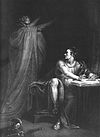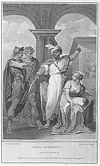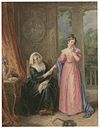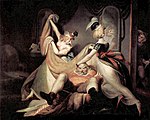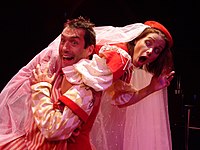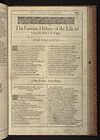User:MainProtagonist/sandbox
William Shakespeare | |
|---|---|
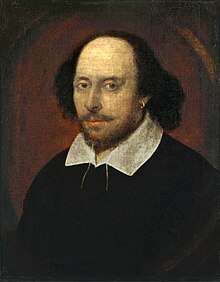 The Chandos portrait (held by the National Portrait Gallery, London) | |
| Born | Stratford-upon-Avon, England |
| Baptised | 26 April 1564 |
| Died | 23 April 1616 (aged 52) Stratford-upon-Avon, England |
| Resting place | Church of the Holy Trinity, Stratford-upon-Avon |
| Occupations |
|
| Years active | c. 1585–1613 |
| Era | |
| Movement | English Renaissance |
| Spouse | |
| Children | |
| Parents |
|
| Signature | |
William Shakespeare (bapt. 26 April 1564 – 23 April 1616)[a] was an English playwright, poet and actor, widely regarded as the greatest writer in the English language and the world's greatest dramatist.[2][3][4] He is often called England's national poet and the "Bard of Avon" (or simply "the Bard").[5][b] His extant works, including collaborations, consist of some 39 plays,[c] 154 sonnets, three long narrative poems, and a few other verses, some of uncertain authorship. His plays have been translated into every major living language and are performed more often than those of any other playwright.[7] They continue to be studied and reinterpreted.
Shakespeare was born and raised in Stratford-upon-Avon, Warwickshire. At the age of 18, he married Anne Hathaway, with whom he had three children: Susanna and twins Hamnet and Judith. Sometime between 1585 and 1592, he began a successful career in London as an actor, writer, and part-owner of a playing company called the Lord Chamberlain's Men, later known as the King's Men. At age 49 (around 1613), he appears to have retired to Stratford, where he died three years later. Few records of Shakespeare's private life survive; this has stimulated considerable speculation about such matters as his physical appearance, his sexuality, his religious beliefs and whether the works attributed to him were written by others.[8][9][10]
Life[edit]
Early life[edit]
Shakespeare was the son of John Shakespeare, an alderman and a successful glover (glove-maker) originally from Snitterfield in Warwickshire, and Mary Arden, the daughter of an affluent landowning family.[11] He was born in Stratford-upon-Avon, where he was baptised on 26 April 1564. His date of birth is unknown, but is traditionally observed on 23 April, Saint George's Day.[12] This date, which can be traced to William Oldys and George Steevens, has proved appealing to biographers because Shakespeare died on the same date in 1616.[13][14] He was the third of eight children, and the eldest surviving son.[15]
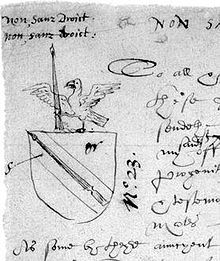
Later years and death[edit]

Rowe was the first biographer to record the tradition, repeated by Johnson, that Shakespeare retired to Stratford "some years before his death".[16][17] He was still working as an actor in London in 1608; in an answer to the sharers' petition in 1635, Cuthbert Burbage stated that after purchasing the lease of the Blackfriars Theatre in 1608 from Henry Evans, the King's Men "placed men players" there, "which were Heminges, Condell, Shakespeare, etc.".[18] However, it is perhaps relevant that the bubonic plague raged in London throughout 1609.[19][20] The London public playhouses were repeatedly closed during extended outbreaks of the plague (a total of over 60 months closure between May 1603 and February 1610),[21] which meant there was often no acting work. Retirement from all work was uncommon at that time.[22] Shakespeare continued to visit London during the years 1611–1614.[16] In 1612, he was called as a witness in Bellott v Mountjoy, a court case concerning the marriage settlement of Mountjoy's daughter, Mary.[23][24] In March 1613, he bought a gatehouse in the former Blackfriars priory;[25] and from November 1614, he was in London for several weeks with his son-in-law, John Hall.[26] After 1610, Shakespeare wrote fewer plays, and none are attributed to him after 1613.[27] His last three plays were collaborations, probably with John Fletcher,[28] who succeeded him as the house playwright of the King's Men. He retired in 1613, before the Globe Theatre burned down during the performance of Henry VIII on 29 June.[27]

Good frend for Iesvs sake forbeare,
To digg the dvst encloased heare.
Bleste be yͤ man yͭ spares thes stones,
And cvrst be he yͭ moves my bones.[29][e]
(Modern spelling: Good friend, for Jesus' sake forbear, / To dig the dust enclosed here. / Blessed be the man that spares these stones, / And cursed be he that moves my bones.)
Textual sources[edit]

In 1623, John Heminges and Henry Condell, two of Shakespeare's friends from the King's Men, published the First Folio, a collected edition of Shakespeare's plays. It contained 36 texts, including 18 printed for the first time.[30] Many of the plays had already appeared in quarto versions—flimsy books made from sheets of paper folded twice to make four leaves.[31] No evidence suggests that Shakespeare approved these editions, which the First Folio describes as "stol'n and surreptitious copies".[32] Nor did Shakespeare plan or expect his works to survive in any form at all; those works likely would have faded into oblivion but for his friends' spontaneous idea, after his death, to create and publish the First Folio.[33]
Alfred Pollard termed some of the pre-1623 versions as "bad quartos" because of their adapted, paraphrased or garbled texts, which may in places have been reconstructed from memory.[31][32][34] Where several versions of a play survive, each differs from the other. The differences may stem from copying or printing errors, from notes by actors or audience members, or from Shakespeare's own papers.[35][36] In some cases, for example, Hamlet, Troilus and Cressida, and Othello, Shakespeare could have revised the texts between the quarto and folio editions. In the case of King Lear, however, while most modern editions do conflate them, the 1623 folio version is so different from the 1608 quarto that the Oxford Shakespeare prints them both, arguing that they cannot be conflated without confusion.[37]
Influence[edit]

Shakespeare's work has made a lasting impression on later theatre and literature. In particular, he expanded the dramatic potential of characterisation, plot, language, and genre.[38] Until Romeo and Juliet, for example, romance had not been viewed as a worthy topic for tragedy.[39] Soliloquies had been used mainly to convey information about characters or events, but Shakespeare used them to explore characters' minds.[40] His work heavily influenced later poetry. The Romantic poets attempted to revive Shakespearean verse drama, though with little success. Critic George Steiner described all English verse dramas from Coleridge to Tennyson as "feeble variations on Shakespearean themes."[41]
According to Guinness World Records, Shakespeare remains the world's best-selling playwright, with sales of his plays and poetry believed to have achieved in excess of four billion copies in the almost 400 years since his death. He is also the third most translated author in history.[42]
Critical reputation[edit]
"He was not of an age, but for all time."
Shakespeare was not revered in his lifetime, but he received a large amount of praise.[44][45] In 1598, the cleric and author Francis Meres singled him out from a group of English playwrights as "the most excellent" in both comedy and tragedy.[46][47] The authors of the Parnassus plays at St John's College, Cambridge, numbered him with Chaucer, Gower, and Spenser.[48] In the First Folio, Ben Jonson called Shakespeare the "Soul of the age, the applause, delight, the wonder of our stage", although he had remarked elsewhere that "Shakespeare wanted art" (lacked skill).[43]
Works[edit]
Speculation about Shakespeare[edit]
Authorship[edit]
Around 230 years after Shakespeare's death, doubts began to be expressed about the authorship of the works attributed to him.[49] Proposed alternative candidates include Francis Bacon, Christopher Marlowe, and Edward de Vere, 17th Earl of Oxford.[50] Several "group theories" have also been proposed.[51] Only a small minority of academics believe there is reason to question the traditional attribution,[52] but interest in the subject, particularly the Oxfordian theory of Shakespeare authorship, continues into the 21st century.[53][54][55]
See also[edit]
Notes and references[edit]
Notes[edit]
- ^ Dates follow the Julian calendar, used in England throughout Shakespeare's lifespan, but with the start of the year adjusted to 1 January (see Old Style and New Style dates). Under the Gregorian calendar, adopted in Catholic countries in 1582, Shakespeare died on 3 May.[1]
- ^ The "national cult" of Shakespeare, and the "bard" identification, dates from September 1769, when the actor David Garrick organised a week-long carnival at Stratford to mark the town council awarding him the freedom of the town. In addition to presenting the town with a statue of Shakespeare, Garrick composed a doggerel verse, lampooned in the London newspapers, naming the banks of the Avon as the birthplace of the "matchless Bard".[6]
- ^ The exact figures are unknown. See Shakespeare's collaborations and Shakespeare Apocrypha for further details.
- ^ The crest is a silver falcon supporting a spear, while the motto is Non Sanz Droict (French for "not without right"). This motto is still used by Warwickshire County Council, in reference to Shakespeare.
- ^ In the scribal abbreviations ye for the (3rd line) and yt for that (3rd and 4th lines) the letter y represents th: see thorn.
References[edit]
- ^ Schoenbaum 1987, p. xv.
- ^ Greenblatt 2005, p. 11.
- ^ Bevington 2002, pp. 1–3.
- ^ Wells 1997, p. 399.
- ^ Dobson 1992, pp. 185–186.
- ^ McIntyre 1999, pp. 412–432.
- ^ Craig 2003, p. 3.
- ^ Shapiro 2005, pp. xvii–xviii.
- ^ Schoenbaum 1991, pp. 41, 66, 397–398, 402, 409.
- ^ Taylor 1990, pp. 145, 210–223, 261–265.
- ^ Schoenbaum 1987, pp. 14–22.
- ^ Schoenbaum 1987, pp. 24–26.
- ^ Schoenbaum 1987, pp. 24, 296.
- ^ Honan 1998, pp. 15–16.
- ^ Schoenbaum 1987, pp. 23–24.
- ^ a b Ackroyd 2006, p. 476.
- ^ Wood 1806, pp. ix–x, lxxii.
- ^ Smith 1964, p. 558.
- ^ Ackroyd 2006, p. 477.
- ^ Barroll 1991, pp. 179–182.
- ^ Bate 2008, pp. 354–355.
- ^ Honan 1998, pp. 382–383.
- ^ Honan 1998, p. 326.
- ^ Ackroyd 2006, pp. 462–464.
- ^ Schoenbaum 1987, pp. 272–274.
- ^ Honan 1998, p. 387.
- ^ a b Schoenbaum 1987, p. 279.
- ^ Honan 1998, pp. 375–378.
- ^ Schoenbaum 1987, p. 306.
- ^ Wells et al. 2005, p. xxxvii.
- ^ a b Wells et al. 2005, p. xxxiv.
- ^ a b Pollard 1909, p. xi.
- ^ Mays & Swanson 2016.
- ^ Maguire 1996, p. 28.
- ^ Bowers 1955, pp. 8–10.
- ^ Wells et al. 2005, pp. xxxiv–xxxv.
- ^ Wells et al. 2005, pp. 909, 1153.
- ^ Chambers 1944, p. 35.
- ^ Levenson 2000, pp. 49–50.
- ^ Clemen 1987, p. 179.
- ^ Steiner 1996, p. 145.
- ^ "William Shakespeare:Ten startling Great Bard-themed world records". Guinness World Records. 23 April 2014.
- ^ a b Jonson 1996, p. 10.
- ^ Dominik 1988, p. 9.
- ^ Grady 2001b, p. 267.
- ^ Grady 2001b, p. 265.
- ^ Greer 1986, p. 9.
- ^ Grady 2001b, p. 266.
- ^ Shapiro 2010, pp. 77–78.
- ^ Gibson 2005, pp. 48, 72, 124.
- ^ McMichael & Glenn 1962, p. 56.
- ^ The New York Times 2007.
- ^ Kathman 2003, pp. 620, 625–626.
- ^ Love 2002, pp. 194–209.
- ^ Schoenbaum 1991, pp. 430–440.
Sources[edit]
- Ackroyd, Peter (2006). Shakespeare: The Biography. London: Vintage. ISBN 978-0-7493-8655-9.
- Adams, Joseph Quincy (1923). A Life of William Shakespeare. Boston: Houghton Mifflin. OCLC 1935264.
- "Bard's 'cursed' tomb is revamped". BBC News. 28 May 2008. Retrieved 23 April 2010.
- Fort, J.A. (October 1927). "The Story Contained in the Second Series of Shakespeare's Sonnets". The Review of English Studies. Original Series. III (12): 406–414. doi:10.1093/res/os-III.12.406. ISSN 0034-6551 – via Oxford Journals.
- Hales, John W. (26 March 1904). "London Residences of Shakespeare". The Athenaeum. No. 3987. London: John C. Francis. pp. 401–402.
External links[edit]
- Digital editions
- Exhibitions
- Shakespeare Documented an online exhibition documenting Shakespeare in his own time
- Legacy and criticism
- "Shakespeare and Literary Criticism", BBC Radio 4 discussion with Harold Bloom and Jacqueline Rose (In Our Time, 4 March 1999).
- Other links




